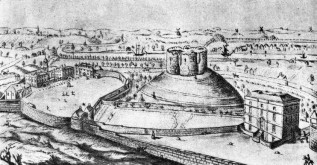Pogrom means ‘to destroy, to wreak havoc, to demolish violently’, a word often used to describe the acts of violence directed towards Jewish communities throughout history. In British history, one of the most famous examples of thisisthe 1190 massacre in York.
After the Crusades, anti-Semitic sentiments had begun to grow in England. Rumours had begun to spiral that Richard I had ordered English Jews to be attacked. Indeed, in 1189 prominent Jews had been denied entry to the coronation of King Richard I, including Bandurch of York, a wealthy and very influential Jew who was later killed in the riots that broke out at Westminster. Riots then spread across England.
On the Sabbath eve before Passover, Jewish households were set on fire and looted. The local Jewish community fled and took refuge in Clifford’s Tower, led by Josce of York – the Jewish leader of York. Rioters attacked the tower for days, whilst the Jews hid in the wooden keep. Meanwhile, the warden of the castle left to discuss the situation. Fearing betrayal the Jews refused to let him back in. The warden appealed to the sheriff who responded by joining the siege with his men. On the 16 March, as it became clear that the castle would not provide protection for much longer, Rabbi Yomtob suggested that the Jews resort to collective suicide. In total 150 Jews perished as a husbands killed their wives and children, and then burnt their bodies before killing themselves. Although some surrendered to the mob, promising to convert to Christianity they were butchered rather than baptised.
Underlying this massacre and fuelling the flames of hate for the Jews were members of the gentry, most notably was Richard de Malbis. These men had extensive debts to Jewish members of the city and no feasible way of repaying them. Thus the massacre provided an opportunity to rid themselves of the debts. After the pogrom, these men burnt all records on the floor of a church and thus absconded from their financial ties to the murdered Jews as well as the King.
An inquiry led to a heavy fine being imposed upon the town;yet no individuals were prosecuted. In fact they may have join Richard I on his crusade has he embarked on his journey to the Holy Land not long after. This was not an anomaly and this pattern of persecution towards the Jewish community has been seen across Europe since. Indeedjust 100 years laterKing Edward I expelled all Jews from England. Only in 1657 did Oliver Cromwell arrange their return.

